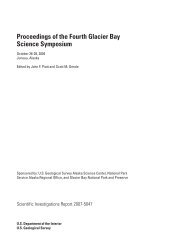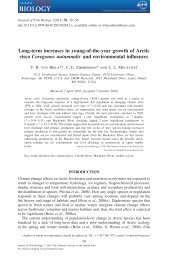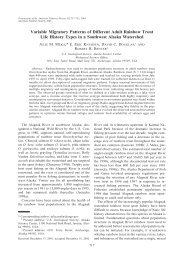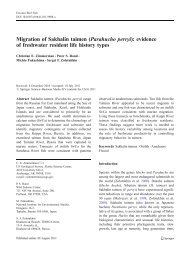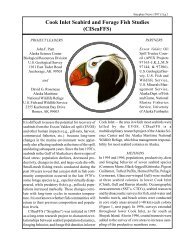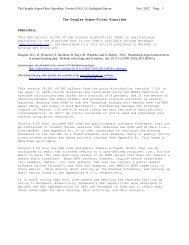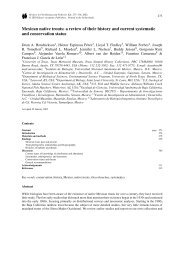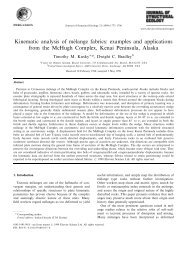Kline, T. C., C. A. Woody, M. A. Bishop, S. P. Powers, and E. E. ...
Kline, T. C., C. A. Woody, M. A. Bishop, S. P. Powers, and E. E. ...
Kline, T. C., C. A. Woody, M. A. Bishop, S. P. Powers, and E. E. ...
You also want an ePaper? Increase the reach of your titles
YUMPU automatically turns print PDFs into web optimized ePapers that Google loves.
KLINE ET AL.<br />
these sources when brought together by<br />
salmon migration.<br />
Nitrogen delivered by returning anadromous<br />
salmon was found to be relatively 15N<br />
enriched compared to alternate N sources<br />
(reviewed by <strong>Kline</strong> et al. 1997). Terrestrial<br />
<strong>and</strong> freshwater ecosystems generally depend,<br />
directly or indirectly, on N fixation from air<br />
N 2 . Nitrogen fixation generates plant material<br />
having a stable N isotope composition<br />
approximately that of air, low in 15N content,<br />
with a δ15N value of 0 0 / 00; by definition.<br />
Marine nitrate <strong>and</strong> ammonium are 15Nenriched<br />
relative to N in air, resulting in 15Nenriched<br />
food web constituents. The relative<br />
increase of 15N that occurs with each feeding<br />
step further elevates 15N levels such that<br />
salmon deliver to terrestrial <strong>and</strong> freshwater<br />
ecosystems N that is more than 1% 15N<br />
enriched relative to air (<strong>Kline</strong> 1991). 15N has<br />
also been shown to be an effective tracer of<br />
MDN in estuarine food webs (Fujiwara <strong>and</strong><br />
Highsmith 1997).<br />
Unlike nitrogen nutrient dynamics, the<br />
sulfur cycle in salmon ecosystems is poorly<br />
described. Sulfate is an important chemical<br />
constituent to the salinity of seawater comprising<br />
the second most common anion, <strong>and</strong> has a<br />
consistent δ34S value of +21 0 / 00 (Michener <strong>and</strong><br />
Schell 1994). Furthermore, δ34S values are<br />
conserved across food web trophic levels (Fry<br />
1988). The δ34S values of marine organisms<br />
are thus generally confined to a narrow range.<br />
For example, δ34S values of organisms from<br />
the Georges Bank ranged from +16–18 0 / 00 (Fry<br />
1988). Freshwater sulfate is relatively 34Sdepleted<br />
with inputs largely due to precipitation<br />
with values ranging from +2–8 0 / 00 (Michener<br />
<strong>and</strong> Schell 1994). For example, the δ34S<br />
values measured in stream water in the Hubbard<br />
Brook Experimental Forest, New Hampshire<br />
ranged from +3.2–4.9 0 / 00 for the<br />
1963–1993 period (Alewell et al. 1999). Sulfur,<br />
however, is significantly 34S-depleted<br />
when reduced to sulfide, so that δ34S values<br />
are reduced about 30–40 0 / 00 relative to sulfate<br />
(Michener <strong>and</strong> Schell 1994). Therefore the<br />
expected δ34S range was from ~ –35 to +5 0 / 00<br />
according to the importance of sulfate reduction<br />
in the system.<br />
Salmon carbon has been found to be generally<br />
13C-enriched relative to freshwater carbon<br />
sources (<strong>Kline</strong> et al. 1990). However, the<br />
δ13C values of primary producers in freshwater<br />
systems may range from very low values<br />
when they take up carbon released from<br />
decomposition to relatively high values in littoral<br />
zones assumed to be due to changing<br />
fractionation effects from depletion of dissolved<br />
inorganic carbon (<strong>Kline</strong> et al. 1993).<br />
Thus δ13C may be a better qualitative than<br />
quantitative indicator of MDC except for<br />
when salmon are consumed directly.<br />
Remineralization (RP) versus Direct<br />
Consumption (DP) Pathways<br />
Stable isotope analysis (SIA) methods can<br />
delineate mdn pathways from salmon to<br />
freshwater biota (<strong>Kline</strong> et al. 1993). The direct<br />
pathway (DP) is whereby salmon components<br />
(organic marine-derived nutrients) are utilized<br />
directly such as when salmon eggs <strong>and</strong><br />
carcasses are fed upon by consumers. Marine<br />
organic mdn is by definition an allochthonous<br />
N, S, <strong>and</strong> C source. The re-mineralization<br />
pathway (RP) is indirect—salmon nutrients<br />
return to an inorganic state (inorganic marinederived<br />
nutrients) <strong>and</strong> therefore must be<br />
taken up by primary producers to re-enter the<br />
food chain. Marine N, S, <strong>and</strong> C are decoupled<br />
during decomposition. For example, primary<br />
producers taking up inorganic marine N<br />
through the RP could have C <strong>and</strong> S isotope<br />
compositions that are different from that of<br />
returning salmon. N, S, <strong>and</strong> C derived from<br />
RP is autochthonous production. The RP can<br />
result from nutrient releases taking place prior<br />
to decomposition of the carcasses. For example,<br />
approximately 30% of the N delivered by<br />
52




